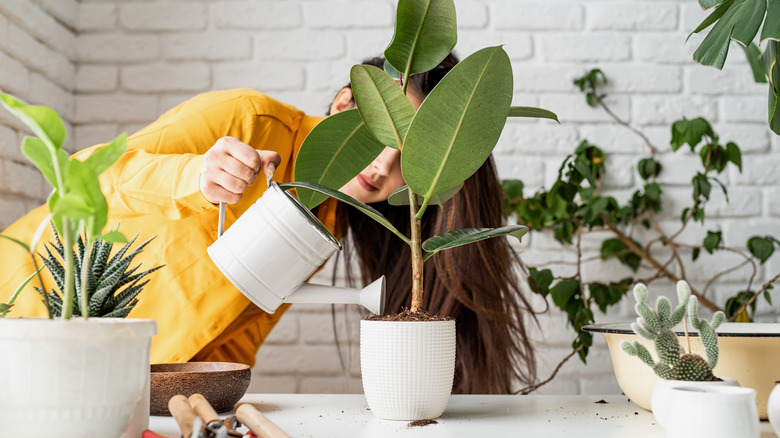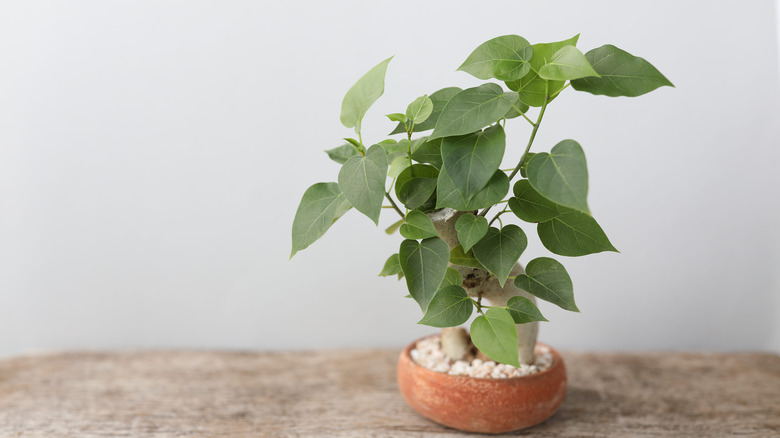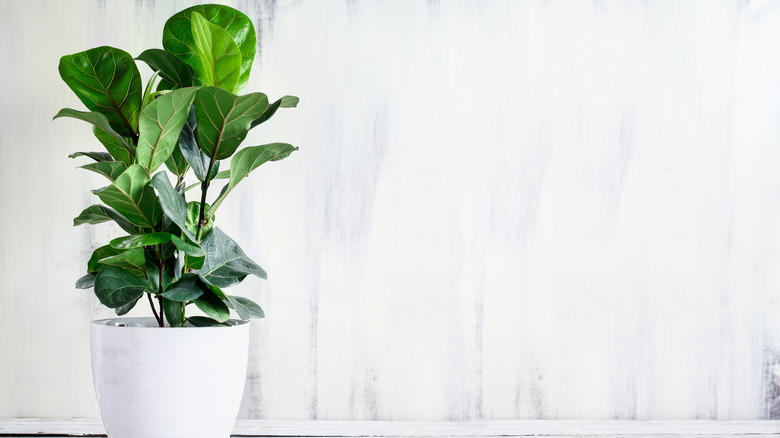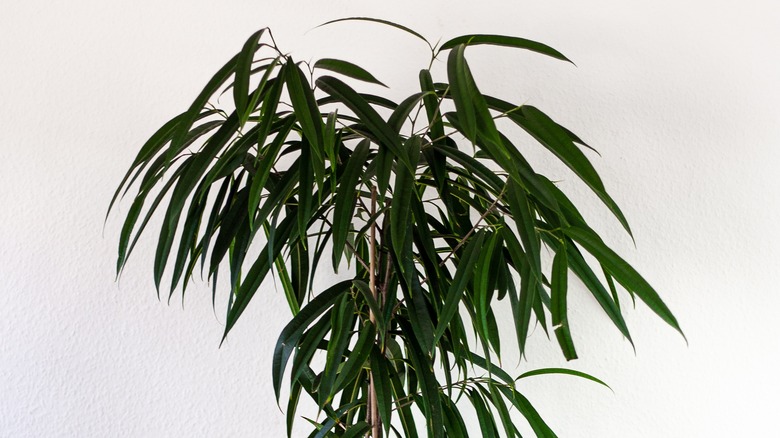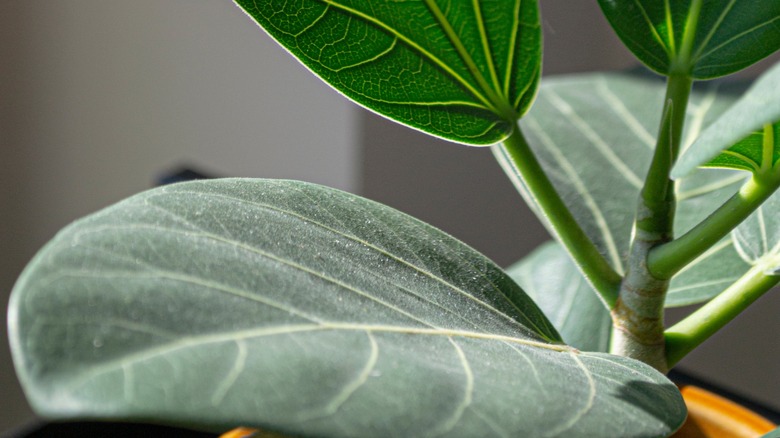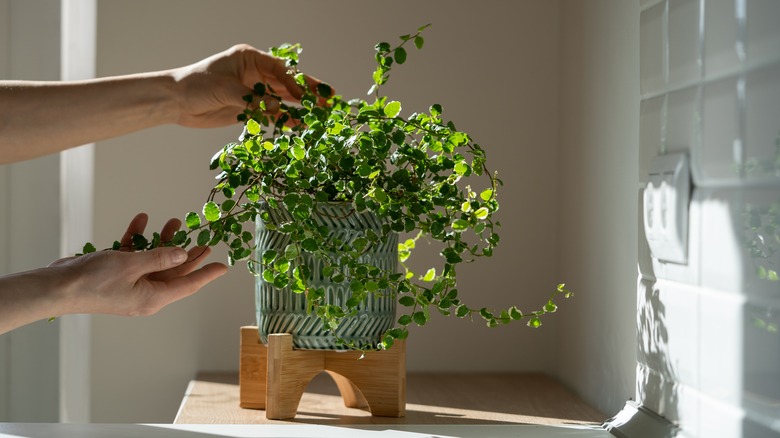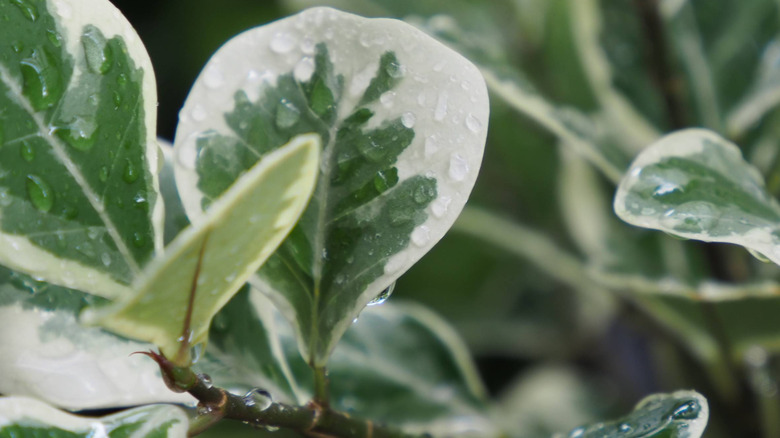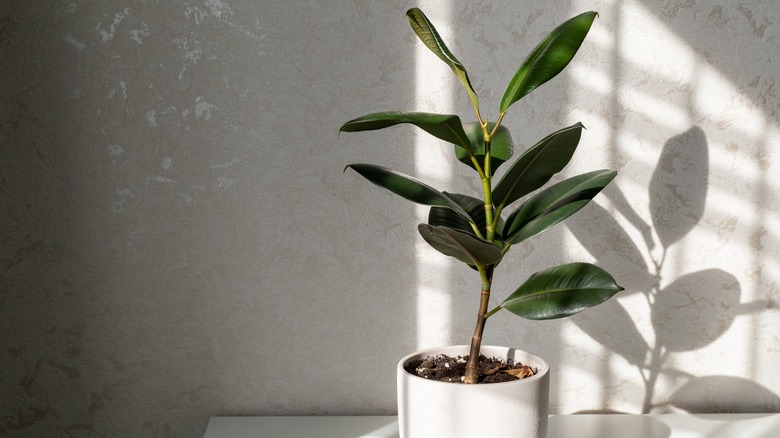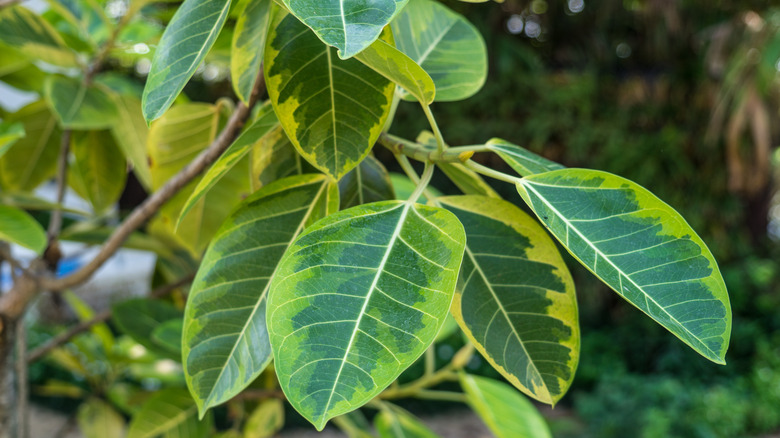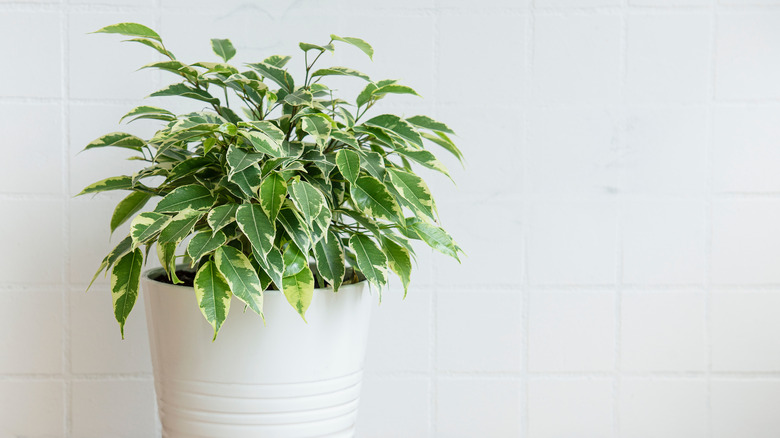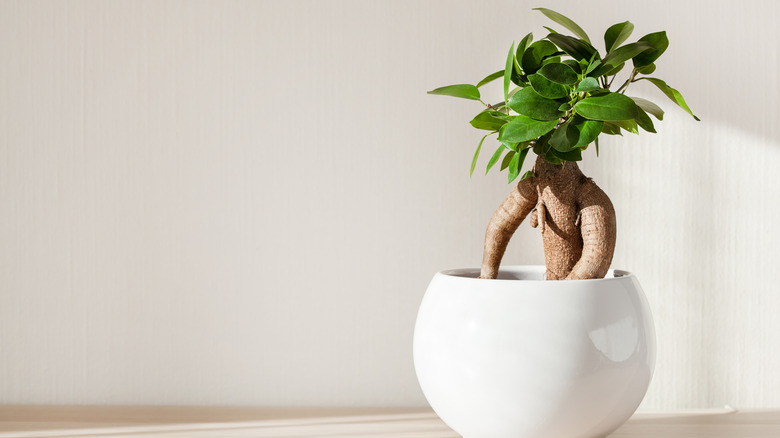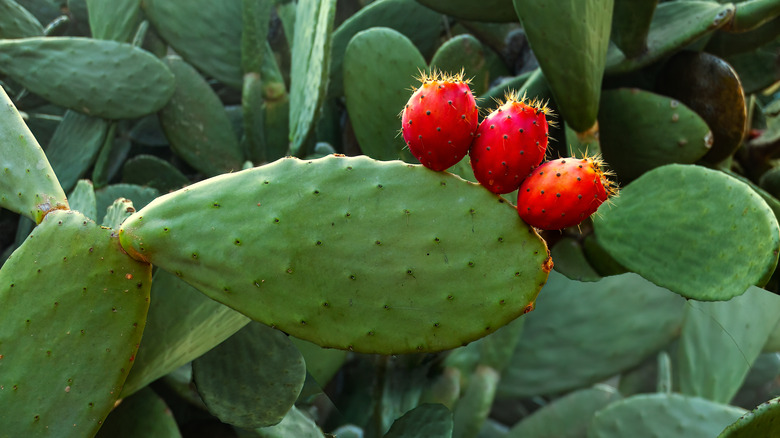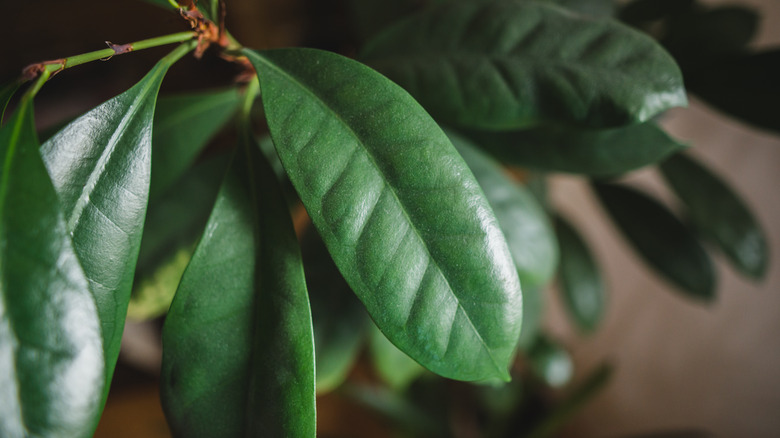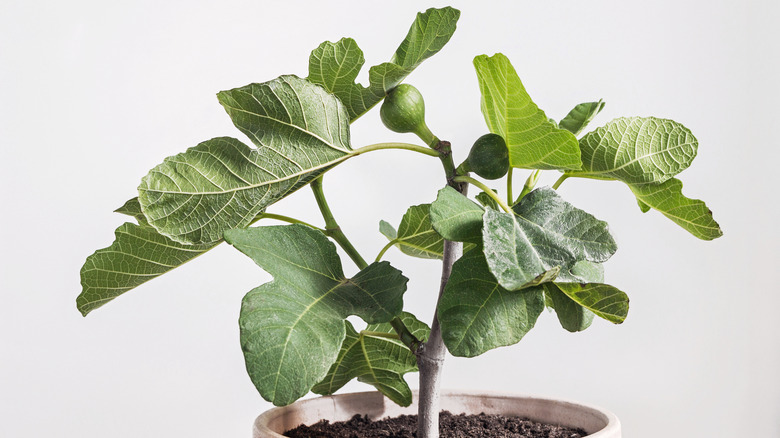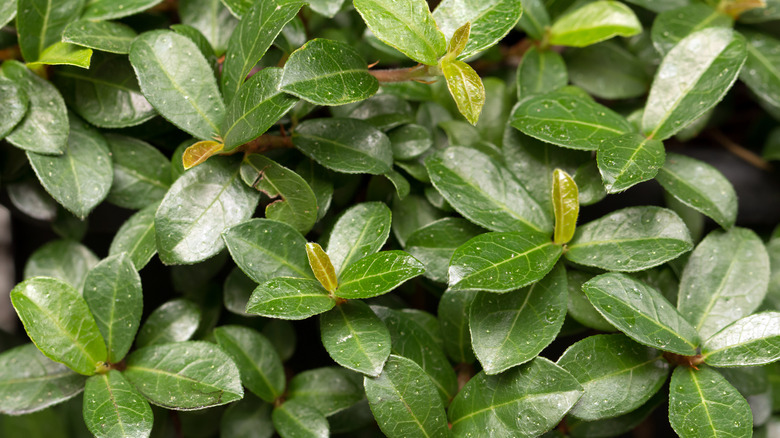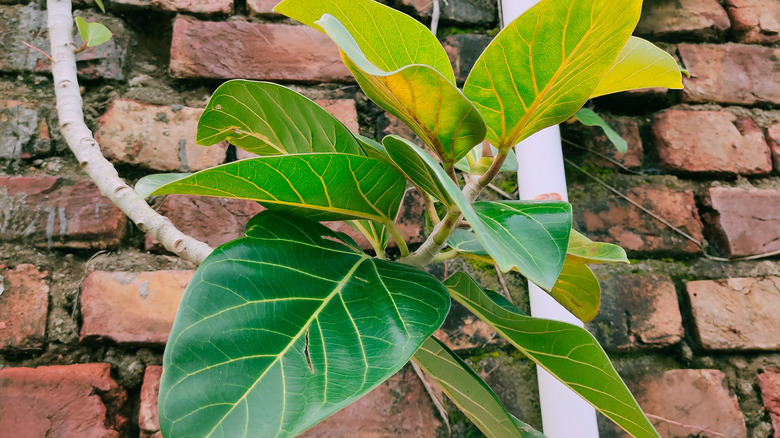15 Ficus Plants That Will Bring Nature Into Your Home
When you are looking for a new houseplant to add to your indoor garden, look no further than ficus or fig plants. These fast-growing plants are most often known for their low-maintenance care requirements and thick, gorgeous green leaves. Better still, there are many different varieties to choose from. According to Purdue University, there may be more than 1,000 distinct species within the Ficus genus.
Ficus plant species such as the sacred fig and Chinese banyan are regularly raised as bonsai trees in medium-sized containers where you can easily control their growth. Other species like the fiddle leaf fig, rubber trees, and weeping figs are grown much larger as container plants, sometimes to more than 6 feet tall. Whether you are looking for a new hobby such as bonsai cultivation, or you're simply looking to bring more nature into your home, one of the following 15 ficus plants is sure to fit your needs and aesthetic preferences.
1. Sacred fig
The sacred fig (Ficus religiosa) is a large tree that holds much historical and religious significance, as noted by Urban Forest Ecosystems Institute. These trees are important within the Buddhist community where many are grown as bonsai. Indoors, you will want to keep your sacred fig in an indirectly lit sunny location and water it regularly.
Bloom Season: Rarely flowers indoors
USDA Growing Zone: 10 to 12
Growing Conditions: Medium to bright indirect light
Soil Type: Loam or sand
Size: Up to 100 feet, much smaller indoors
2. Fiddle leaf fig
Like many other ficus species, the fiddle leaf fig (Ficus lyrata) grows extremely tall in nature, but it is usually kept small as a houseplant. As per Missouri Botanical Garden, this plant is named after its leaves which are shaped like violins. When growing this fig, be sure to provide it with indirect light from a sunny window and water it often during its growing season.
Bloom Season: Rarely flowers indoors
USDA Growing Zone: 10 to 12
Growing Conditions: Medium indirect light
Soil Type: Soil-based potting mix
Size: 2 to 10 feet indoors
3. Long leaf fig
Also named the banana leaf fig, the long leaf fig (Ficus maclellandii) has slender leaves along thin branches. Though this plant does technically flower, its flowers develop within the fruit where fig wasps will pollinate them in their native environment, as told by North Carolina State Extension. Long leaf figs are low-maintenance. Be sure to keep yours out of direct sunlight.
Bloom Season: Rarely flowers indoors
USDA Growing Zone: 10 to 11
Growing Conditions: Medium or low light
Soil Type: Well-draining
Size: 6 to 10 feet tall
4. Banyan tree
The banyan tree (Ficus benghalensis) is known worldwide for its towering height and large canopy. However, like many other ficus species, it can be grown in a container indoors where you can easily monitor its growth rate. Banyans are relatively easy to care for as they are very drought-tolerant and can be planted in almost any type of soil, as explained by Tree World Wholesale.
Bloom Season: Spring
USDA Growing Zone: 10 to 11
Growing Conditions: Bright direct light
Soil Type: Any soil type
Size: Up to 100 feet, much smaller indoors
5. Climbing fig
Climbing figs (Ficus pumila) are creepers that can climb walls and fences. They also do great as houseplants when trained up moss poles, as mentioned by Guide to Houseplants. Native to eastern Asia, climbing figs enjoy warm temperatures and indirect sunlight. Leaves will drape nicely over the sides of a hanging basket or a container placed on a shelf.
Bloom Season: Rarely blooms indoors
USDA Growing Zone: 9 to 11
Growing Conditions: Medium to bright light
Soil Type: Well-draining chalk, clay, loam, or sand
Size: 10 to 15 feet tall, smaller when grown indoors
6. Mistletoe fig
The mistletoe fig (Ficus deltoidea) is sometimes called the delta fig or the fig shrub. It can be identified by its rounded, waxy leaves that are green on the top and yellow underneath, as described by North Carolina State Extension. This small indoor tree also produces inedible fruit year-round which offer great ornamental value.
Bloom Season: Rarely flowers indoors
USDA Growing Zone: 10 to 11
Growing Conditions: Medium to bright light
Soil Type: Dry and well-drained
Size: 2 to 3 feet tall, smaller when grown indoors
7. Rubber tree
Rubber tree plants (Ficus elastica) are known to be great for novice gardeners. They require little maintenance, and are difficult to kill. This plant is praised for its large, leathery leaves that can be shades of green, gray, pink, white, or red, according to Clemson Cooperative Extension. When growing a rubber tree houseplant, be careful not to overwater them, but do fertilize them regularly.
Bloom Season: Spring and summer, rarely flowers indoors
USDA Growing Zone: 10 to 11
Growing Conditions: High, medium, or low light
Soil Type: Well-draining houseplant potting mix
Size: 6 to 10 feet tall
8. Council tree
The council tree (Ficus altissima) is an epiphytic fig that can grow as tall as 100 feet in its natural environment. Yet, when it's grown as a houseplant, it won't become any taller than 6 feet, promises Fiddle Leaf Fig Plant Resource. This plant sports large leaves similar to the rubber tree, however, the leaves of the council tree feature lime green tips and a darker green center.
Bloom Season: Rarely blooms indoors
USDA Growing Zone: 9 to 12
Growing Conditions: Bright, indirect light
Soil Type: Cactus soil or well-draining indoor potting mix
Size: 6 feet tall
9. Weeping fig
The weeping fig (Ficus benjamina) is certainly one of the most well-known fig species grown as houseplants. As mentioned by Clemson Cooperative Extension, weeping figs are ornamental plants that can be bent into shapes such as hearts, arches, and braids for more visual interest. All you need to do to keep this plant alive is provide it with plenty of indirect sunlight and water it to keep the soil evenly moist.
Bloom Season: Does not flower
USDA Growing Zone: 10 to 12
Growing Conditions: Bright indirect sunlight
Soil Type: Well-draining
Size: 3 to 6 feet tall
10. Chinese banyan
Chinese banyans (Ficus microcarpa) are used outdoors as shade trees due to their 40-foot wide crowns. Yet, they can also fill the opposite role of indoor bonsai, says North Carolina State Extension. Native to the tropical and subtropical regions of Asia, this small tree needs high humidity to survive. When growing indoors, keep it in a sunny window where it will stay warm and keep its soil moist.
Bloom Season: Rarely flowers indoors
USDA Growing Zone: 9 to 11
Growing Conditions: Bright light
Soil Type: Well-draining loam or sand
Size: 40 feet tall outdoors, smaller when grown indoors
11. Prickly pear fig
The prickly pear fig (Opuntia ficus-indica) doesn't look like other fig plants. It is a succulent shrub cultivated in warm, dry regions like California and Mexico. Prickly pear figs are characterized by flat, ovate pads covered in spines. The tips of these pads feature orange and red flowers in the spring and edible fruit in the summer and fall, per World of Succulents.
Bloom Season: Spring and summer
USDA Growing Zone: 8 to 12
Growing Conditions: Bright direct light
Soil Type: Well-draining loam or sand
Size: 10 to 15 feet outdoors, smaller when grown indoors
12. African fig tree
African fig trees (Ficus cyathistipula) are beautiful houseplants that present thick, glossy leaves that grow on upright stems. RHS Plants explains that African figs are simple to care for. They require infrequent watering, moderate humidity, and indirect sunlight. They will even tolerate low light conditions provided they are kept warm.
Bloom Season: Rarely flowers indoors
USDA Growing Zone: 9 to 12
Growing Conditions: Bright, indirect light
Soil Type: Well-drained potting compost
Size: Up to 10 feet tall and 6 feet wide, smaller when grown indoors
13. Common fig
Common fig trees (Ficus carica) are not normally grown indoors because they need lots of space and sunlight to produce their delicious fruit. However, one cultivar, 'Petite Negra', is a dwarf variety that only grows to 2 or 3 feet tall, explains Missouri Botanical Gardens. Consider keeping this potted plant on your porch during the summer and inside near a sunny window in the winter.
Bloom Season: Spring
USDA Growing Zone: 7 to 9
Growing Conditions: Medium to bright light
Soil Type: Well-draining sand, loam, or clay
Size: 2 to 3 feet tall and wide when grown indoors
14. Creeping fig
There are a few different species of creeping fig plants (Ficus vaccinioides), though this one is not the most common. According to San Marcos Growers, Ficus vaccinioides is often grown as ground cover, but it also does well climbing on trellises and walls. Indoors, the creeping fig can be grown in pots or in hanging baskets where its round leaves can either cascade downward or climb upward with support.
Bloom Season: Summer
USDA Growing Zone: 7 to 10
Growing Conditions: Medium to low light
Soil Type: Well-draining
Size: 4 to 24 feet in length
15. White fig
The white fig (Ficus virens) is a tree that can reach more than 100 feet tall when grown in its native habitat. As per National Parks of Singapore, this plant has leathery veined leaves that are oval-shaped. It produces round, purple fruits that are eaten by birds and squirrels. The white fig makes a great ornamental container plant that can be kept indoors or out.
Bloom Season: Rarely blooms indoors
USDA Growing Zone: 7 to 9
Growing Conditions: Bright light
Soil Type: Well-draining
Size: More than 100 feet tall, smaller when grown indoors
